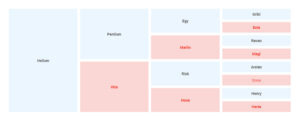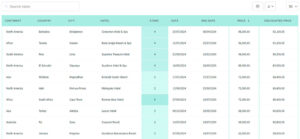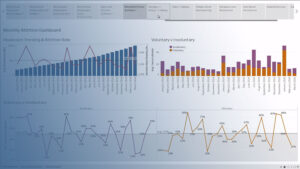Picture this: You’re sorting your epic movie collection. Some are ranked by your go-to “rewatchability” factor, while others are grouped by genre—comedy, drama, you name it. That’s when it strikes you, your organizing method is more than just a personal quirk, it’s data in action!
We’re diving into the fascination of categorical data, breaking down the showdown of nominal vs ordinal data. These are the unsung heroes of statistical scales that power the insights from survey research to data visualization.
By the tail end of our chat, you’ll be savvy enough to distinguish these types in your sleep, whether you’re eyeballing frequency distributions or decoding data types in statistics.
Ready for the lowdown? We’ll unpack definitions, drop examples, and even touch on why understanding measurement scales is a game changer. Plus, we’re doing it all with crystal-clear clarity—no statistical jargon in sight.
Table of Contents
- Understanding Nominal Data
- Exploring Ordinal Data
- Nominal vs Ordinal Data: Key Differences and Similarities
- Data Collection Techniques
- Practical Applications in Research and Business
Understanding Nominal Data
Definition and Key Characteristics
Let’s dive into the world of nominal data. Think of it like tagging things without worrying about their quantity or order. It’s like naming your pets; each name is unique but doesn’t tell you anything about their size or age.
Characteristics of Nominal Data:
- Non-Quantifiable: It’s all about labels and names. No numbers to crunch here.
- No Intrinsic Order: Imagine a bag of multicolored marbles. The colors are different, but one isn’t ‘higher’ or ‘better’ than another.
- Distinct Categories: Each label is its own thing. Like different genres in a music store – rock, jazz, classical, each unique.
Examples of Nominal Data
Nominal data is everywhere! Here are some classic examples:
- Religion: Categories like Christianity, Islam, Hinduism, Atheism.
- Hair Color: Blonde, brunette, redhead, you name it.
- Marital Status: Single, married, divorced, etc.
Application and Analysis
Nominal data is super handy, especially in market segmentation and research. It’s like sorting your playlist according to genres, not by song length or release date.
How do we analyze this stuff?
- Grouping: Think of it like organizing a library by genres. Each book (data point) gets its own shelf.
- Calculating Percentages or Modes: It’s about finding the most common label in your dataset. Like figuring out the most popular genre in your music collection.
In this maze of labels and categories, it’s crucial to understand how nominal data differs from ordinal data. The comparison, nominal vs ordinal data, isn’t just academic jargon; it’s the backbone of categorizing information effectively.
For those who are looking to get deeper into the fascinating world of data, exploring categorical data examples can provide more insight into how nominal data functions in real-world scenarios.
Exploring Ordinal Data
Definition and Key Characteristics
Alright, let’s switch gears and talk about ordinal data. This is the type of data that’s all about order but not in a number-crunching way.
Think of it like a podium finish in a race – first, second, third. You know the order, but how much faster was first from third? That’s not here.
Key Traits of Ordinal Data:
- Ordered Categories: It’s like having a leaderboard. You can tell who’s leading, but not by how much.
- Relative Positioning: Consider movie ratings. A 5-star movie is above a 4-star, but is it exactly one star better? Who knows?
- Non-Arithmetic Nature: You can’t just add and subtract these. It’s not about quantities; it’s the sequence that counts.
Examples of Ordinal Data
Ordinal data pops up in daily life more than you might think:
- Education Levels: From high school to a Ph.D., it’s a journey with clear steps, but not measurable distances.
- Customer Satisfaction Ratings: Ever rated something 4 out of 5? That’s ordinal data in action.
- Economic Status: Terms like lower, middle, and upper class denote order, but they’re not precise income brackets.
Application and Analysis
When it comes to using ordinal data, it shines in areas like surveys. It’s perfect for gauging perceptions and preferences.
Analyzing Ordinal Data: How’s It Done?
- Computing Mode and Median: These are your go-to stats. They tell you the most common and the middle rating, respectively.
- Quartiles and Percentiles: These guys break down your data into chunks to see distribution. Like cutting a cake into quarters to see who gets the most icing.
In the grand scheme of things, understanding the nuances of ordinal data is vital. Especially when you’re comparing nominal vs ordinal data. It’s like comparing apples and oranges – both fruit, but oh so different.
For those interested in a deeper dive, understanding different types of data can enrich your grasp of how ordinal data plays a unique role in data analysis.
Your beautiful data deserves to be online
wpDataTables can make it that way. There’s a good reason why it’s the #1 WordPress plugin for creating responsive tables and charts.

And it’s really easy to do something like this:
- You provide the table data
- Configure and customize it
- Publish it in a post or page
And it’s not just pretty, but also practical. You can make large tables with up to millions of rows, or you can use advanced filters and search, or you can go wild and make it editable.
“Yeah, but I just like Excel too much and there’s nothing like that on websites”. Yeah, there is. You can use conditional formatting like in Excel or Google Sheets.
Did I tell you you can create charts too with your data? And that’s only a small part. There are lots of other features for you.
Nominal vs Ordinal Data: Key Differences and Similarities
Major Differences
Intrinsic Ordering
Imagine you’re lining up your favorite comic books. With ordinal data, it’s like ranking them from most to least favorite – there’s a clear order.
Nominal data? It’s more like sorting them by genre. There’s no ‘first’ or ‘last’; it’s all about categorization.
- Nominal Data: No inherent order. Think of it as naming different ice cream flavors.
- Ordinal Data: Comes with a built-in ranking system, like a leaderboard.
Nature of Categories and Their Analysis
When it comes to breaking things down:
- Nominal Data: It’s about labeling. Analysis is often about counting how many fall into each category.
- Ordinal Data: Here, you’re not just labeling; you’re also placing in an order. Analysis might involve figuring out medians or modes.
Application in Different Research Contexts
- Nominal Data: It’s a superstar in market research. Like segmenting customers based on their interests.
- Ordinal Data: Think of customer feedback surveys. It’s all about understanding preferences.
Similarities
Even though nominal vs ordinal data are different, they share some common ground:
- Both are Types of Categorical Data: They’re about putting things into buckets, not measuring them.
- Qualitative Nature: It’s all about the quality, not quantity.
- Visualization Techniques: They both love a good pie chart or bar graph. Visual storytelling is key in presenting this kind of data. To get a grip on how to do this effectively, check out data visualization principles.
Understanding the Overlap
- Research Settings: Both types of data are heroes in research. They help understand trends, preferences, and patterns.
- Data Storytelling: Whether it’s nominal or ordinal, it’s about telling a story with data. For some impressive ways to do this, one can explore impressive data storytelling examples.
Data Collection Techniques
Techniques for Nominal Data
When collecting nominal data, think of it as gathering a bunch of different colored beads. Each color represents a category, like different flavors at an ice cream shop.
- Open-ended Questions: These are like asking, “What’s your favorite ice cream flavor?” You get a range of answers, each a unique flavor.
- Multiple-choice Questions: This is like showing someone a menu and asking them to pick their favorite. You’ve got set options, and each choice falls into a distinct category.
Collecting nominal data is all about labels and categories. It’s not about how much or how many, but about what kind. For a deeper understanding of how this plays out in real-life scenarios, exploring primary data vs secondary data can be super insightful.
Techniques for Ordinal Data
Now, when it’s about ordinal data, you’re stepping into a world where order matters. It’s like ranking those ice cream flavors from most to least favorite.
- Likert Scales: Ever answered a survey with “Strongly agree to strongly disagree”? That’s a Likert scale. It’s about gauging attitudes or feelings on a scale, not just yes or no.
- Rating Scales: Think of movie ratings. A 5-star movie is rated higher than a 3-star, but how much better is it, really?
- Interval Scales: These are a bit trickier. They involve scales where intervals are consistent but without a true zero point. Like measuring temperature.
When we’re analyzing nominal vs ordinal data, these collection techniques play a huge role. They shape how we understand and interpret the data. It’s like choosing the right brush for a painting – the technique you use can totally change the picture.
For those who are keen to dive deeper into the world of data, understanding data visualization for marketers can offer valuable insights into how different data collection techniques impact the end result.
Practical Applications in Research and Business
Market Research and Consumer Behavior
Nominal Data in Action
In market research, nominal data is like your best buddy. It helps you segment the market, like categorizing customers based on their interests or demographics.
- Segmenting Markets: It’s like sorting a deck of cards. You group people by age, gender, or maybe their favorite type of music.
- Understanding Customer Preferences: By analyzing responses to multiple-choice surveys, you get a clear picture of what your audience loves and doesn’t.
Here’s a cool thing – nominal data can be a goldmine for marketers. It’s about understanding the ‘who’ behind the numbers. To dive deeper into this, data visualization for marketers offers some awesome insights.
Ordinal Data at Play
Now, ordinal data steps in when you want to measure things like customer satisfaction. It’s about understanding not just what customers think, but how strongly they feel about it.
- Customer Satisfaction Ratings: These are like the pulse of your business. Using rating scales, you can gauge customer happiness and tailor your services accordingly.
- Product Rankings: Ever wondered how your product stacks up against competitors? Ordinal data gives you that leaderboard.
Educational and Sociological Studies
Assessing Educational Achievements
In education, nominal vs ordinal data help in different ways:
- Nominal Data: It’s used to categorize students – think different majors or departments.
- Ordinal Data: Here’s where grades come in. They rank students’ performances but don’t quantify the exact difference between a B and an A.
Social Status Studies
Sociology loves these data types:
- Nominal Data: It’s used to categorize people based on ethnicity, religion, etc. It’s about understanding the diverse fabric of society.
- Ordinal Data: Think of social class rankings. They give a sense of order but aren’t precise measures of wealth or status.
In essence, whether it’s peering into market trends or understanding societal structures, nominal vs ordinal data are key players.
They’re not just cold, hard facts. They tell stories, uncover patterns, and reveal insights that can transform businesses and enlighten research.
For those looking to enhance their understanding of how data can be visualized in compelling ways, big data visualization provides a window into how complex data can be made accessible and insightful.
FAQ on Nominal vs Ordinal Data
What Is Nominal Data?
You’ve got movie genres, ice cream flavors, car brands. What do they share? They’re all nominal data—labels, pure and simple.
No rank, no order, just like your T-shirts in a drawer, sorted by color but not by which one you’d grab first.
How Does Ordinal Data Differ From Nominal?
Think of a leaderboard in a game. Ordinal data lines things up in order—first, second, third.
There’s a sequence, unlike nominal, which is more like a random mixtape where the track order doesn’t have a meaning in terms of value or hierarchy.
Can You Give Me Examples of Nominal Data?
Alright, say you’ve got a survey with boxes to check your gender, or the type of pet you own. That’s nominal data, right there.
Mutually exclusive categories, and whether you circle ‘cat’, ‘dog’, or ‘dragon’, there’s no hierarchy in that zoo.
How About Some Examples of Ordinal Data?
Imagine customer feedback forms with those satisfaction levels—happy, neutral, frustrated face. Or sizes like small, medium, large.
There’s an intrinsic order in that system, clear as day. Moving from content to irked, or upping from a medium coffee to large. That’s your ordinal data at play.
In Statistics, How Can You Identify Nominal and Ordinal Data?
Let’s crack this nut. When working with data classification, check if you can rank the categories logically—can’t do it? That’s nominal.
If yes, and there’s a clear hierarchy or logical progression, then it’s ordinal. It’s all about whether there’s an actual pecking order or just different kinds.
What Statistical Methods Use Nominal and Ordinal Data?
For nominal, get friendly with the Chi-square test, a go-to for counts and frequencies. With ordinal, I’d chat up non-parametric tests.
They don’t assume a normal distribution and fit snugly with ordinal’s rank-based nature. Each data type has its own statistical toolbox, and now you know a couple of tools from it!
Why Is the Distinction between Nominal and Ordinal Data Important?
Ever put together furniture with the wrong instructions? That’s why. Using the wrong data type can mess up your analysis.
Correctly pinpointing nominal vs ordinal keeps you on point, ensures proper data summarization, and avoids any wonky, unhelpful results. It’s about the right tool for the job.
What Are Some Common Mistakes When Working with These Types of Data?
Mixing up the toolbox. Treating nominal like ordinal—big no-no. You don’t want to start ranking stuff that doesn’t have an inherent order.
It’s also a classic flub to apply the wrong statistical tests. Simply, mixing these up can steer your whole data analysis off course.
Can Nominal or Ordinal Data Be Converted to Other Scales?
Technically, sure. You can drop ordinal down to nominal just fine—remove the order, and it’s all good. But the reverse? That’s forcing a square peg in a round hole.
Nominal data just doesn’t naturally scale up to ordinal without injecting some artificial order, which can be quite dicey for accuracy.
How Does Understanding These Data Types Impact Real-World Applications?
It’s a cornerstone! From marketing strategies honing in on customer segments (nominal data) to clinical research assessing patient pain scales (ordinal data), getting these data types right is clutch.
You tap into accurate insights, craft sharper strategies, and make decisions that are data-driven and on the money. It’s what separates the rookies from the pros.
Conclusion
Wrapping things up, let’s bring it back to the heart of the matter with nominal vs ordinal data. Just like an expertly crafted website has its unique spot in the digital universe, these data types hold their own in the vast world of stats. Different but equally crucial.
We’ve strolled through this jargon-free crash course, from plain as day examples, the types of variables, to the nitty gritty of measurement scales and why they’re pivotal. No doubt, it’s key to nail down whether you’ve got a set of categories or a well-defined order next time you’re knee-deep in data.
Remember, don’t toss ordinal data into the nominal data bin. You wouldn’t scramble the pieces of a puzzle, right? Both types pack a punch in their own ring – just make sure you match the right contender with the right bout.
Cheers to making sense of the data tangle and unleashing its true potential. Knowledge, after all, is power – and now you wield it like a pro.
If you liked this article about nominal vs ordinal data, you should check out this article about categorical data examples.
There are also similar articles discussing discrete vs continuous data examples, descriptive statistics, different types of data, and how to present data visually.
And let’s not forget about articles on real-time data visualization, primary data vs secondary data, advantages of secondary data, and data visualization principles.





